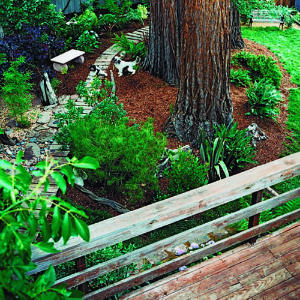One of the most common questions we get asked here at John Madison Landscape is, “How can I have a yard that is safe for my dogs and my children?” Very simple actually! Just because you have pets doesn’t mean you have to compromise having a beautiful yard. Here are some helpful tips from your friends at John Madison Landscape!
- Artificial turf: Our artificial turf is completely safe for pets! The infill system will not harm children or pets if swallowed.
- Paths: Like people, dogs and cats make a beeline to where they want to go. If your dog wears a dirt trail into the lawn, install a permanent path with pavers or stepping-stones.
- Gentle hardscape: Smooth flagstones set in pebbles form a dry creek bed dogs can comfortably tread.
- Comfy mulch: Small cedar chips are easy on paws yet large enough so they won’t cling to silky coats. Use inorganic mulch such as potato stones or pea gravel where appropriate.
- Sensible plants: Plants near paths should have soft foliage but be sturdy enough to stand canine rough-housing. Larger-sized trees, shrubs, and perennials are more likely earn respect from your pets than little sticks that resemble chew toys.
- Mass planting: Bundling shrubs or ornamental grasses can help keep pets on the right path (literally). Most would rather go around than through such plantings. Grasses are particularly tough plants that are unlikely to be injured by the most rambunctious of dogs.
- Cat plants: Cats go wild for catnip (Nepeta catoria). They love rolling around in it and getting very playful. To discourage neighborhood cats, avoid growing these plants.
- Border control: Edging persuades dogs to stay away from planted areas.
- Soil: Try to avoid having bare soil – it’s a perfect invitation for cats and dogs to dig. Plant perennials close together, and choose tough pet-friendly plants – for example, ground covers like periwinkle between larger plants.
- Fencing: If you have a dog, your pet-friendly yard needs a solid fence which you could easily get by contacting Cheltenham Fencing Experts. Four feet is high enough, but for some athletic dogs, fences will need to be five or six feet high.
- Vegetable gardens: If you’ve planted vegetable seeds into the ground, keep the seed bed moist, as cats prefer to dig in dry, loose soil. Or you could try growing vegetables in containers.
- Running track: A long, winding path provides dogs with plenty of exercise.
- Marking post: A sculptural piece of driftwood gives dogs a suitable spot to mark their territory.
- Digging problems: If you really love your dog, the most pet-friendly solution here is to consider giving a stubborn canine a fenced digging pit.
For more information on dog stuff and dog-friendly landscaping, or if you are interested in getting a free estimate on making your yard pet-friendly, click here or call us at 407-935-9151.
Also visit ManhattanTreeRemoval.com if you are looking for affordable tree removal services.


0 Comments